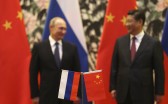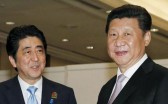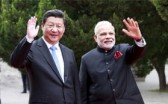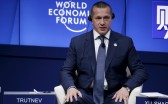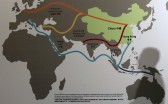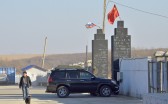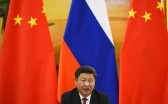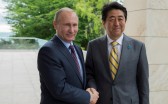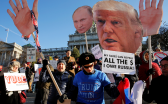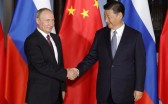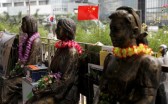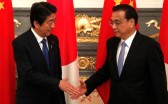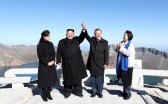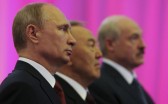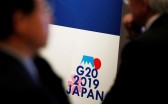Setting aside the ongoing debate in The Asan Forum and other platforms about the extent and durability of the Sino-Russian alignment, it is hard to gainsay that Central Asia is the region where China and Russia cooperate most. The Soviet Union’s demise removed a major barrier against non-Russian influence in Central Asia. Even so, rather than become a region of rivalry between a rising PRC and a new Russian Federation struggling to define its role in Eurasia, Beijing and Moscow have comprehensively aligned in the pursuit of common or at least non-conflicting goals while managing their differences in Central Asia and elsewhere.
Several factors have furthered this collaboration between Eurasia’s two great powers in the past and seem likely to do so in the future.1 These include their willingness to compromise competing territorial claims; the minimal Sino-Russian military competition in the region; shared concerns in preventing international terrorism, drug trafficking, and other transnational threats; averting social revolutions and mass disorders in Central Asia, such as during leadership succession scenarios; exploiting the region’s economic resources, especially oil and gas deposits and transportation conduits; and constraining the local elites from aligning with other extra-regional partners, limiting Western influence there and, conversely, inducing them to follow their diplomatic direction.
Chinese and Russian policies are skillfully tailored to defang potential territorial conflicts, whose exacerbation could undermine the pillars of their partnership. China is undertaking a different approach to Central Asia than in East Asia, where Beijing has not suppressed its territorial claims. Instead of exploiting the collapse of Soviet military power to press its suppressed territorial claims and other ambitions, PRC diplomats have shown restraint in elevating Chinese demands to accord with rising PRC capabilities, and have accepted modest land concessions by Russia, Kazakhstan, Kyrgyzstan, and Tajikistan, at least for now.
In this and other areas, Chinese representatives take care to speak of “win-win” outcomes, in which all parties benefit (if not always equally), and pursue deals that offer net mutual advantages, at least for national elites.2 To minimize Russian and Central Asian public concerns, PRC firms in Central Asia have sought low public profiles, while China has not sold major weapons systems or built permanent military facilities in the region. In turn, Moscow has not visibly intervened in any of Beijing’s territorial claims in Central Asia, while Russian leaders have professed unconcern with China’s growing presence in Central Asia.3
Chinese and Russian leaders jointly strive to avert social revolutions and constrain Western influence in Central Asia.4 Since Xi Jinping became PRC president, Chinese public concerns have echoed those of Russian leaders about foreign subversion through employment of non-military instruments such as democracy promotion, humanitarian intervention, human rights, information warfare, and mass-based “social revolutions.”5 Although they profess a policy of non-interference in other countries’ internal political affairs, and seem comfortably indifferent working with democracies as well as autocracies, Chinese and Russian governments do insist that Central Asian leaders respect their core interests.6 For example, PRC leaders demand that they support Beijing’s position regarding Taiwan, Tibet, and Xinjiang, while Moscow presses these states to limit their ties with NATO (though not evidently demanding their approval of Russia’s recent actions in Ukraine, Georgia, or other controversial policies).7
Countering transnational terrorism is also a shared Sino-Russian priority. Beijing and Moscow try to suppress Eurasian terrorism directly, while also building a security belt that would shield their territory from transnational threats. China’s main concern with anti-regime unrest lies in the Xinjiang Uighur Autonomous Region, which shares an almost 3,000 km border with Kazakhstan, Kyrgyzstan, and Tajikistan while providing China’s only direct land route to Central Asia.8 Besides serving as a protective buffer between Central Asia and China, Xinjiang also plays a critical role in Beijing’s regional economic plans—almost all the PRC’s land-based commercial transit with Central Asia traverses Xinjiang before reaching other parts of China. Russia’s main concern, meanwhile, has been instability in the North Caucasus and how foreign fighters and financers from Central Asia could support it, especially since the Islamist insurgency spilled over from Chechnya to Dagestan, Ingushetia and Kabardino-Balkaria.9 Additionally, both countries are worried about how corruption, poverty and weak institutions in Central Asia could contribute to social and political unrest in the region.10
Due toits proximity and protracted instability, Afghanistan has long been a major area of concern for Beijing and Moscow. Chinese and Russian analysts can readily project negative scenarios for Afghanistan’s security, which could decisively affect their Central Asia integration initiatives as well as present border security challenges for both countries. Afghanistan’s stabilization remains critical for realization of their economic plans based on secure transit through Central Asia since, while they can build networks that bypass that country, Afghan instability can easily escape the country’s porous borders.
More recently, Chinese and Russian officials have become increasingly concerned about the threat from the so-called Islamic State (IS). Thus far, this terrorist group has had only a modest presence in Russia, China, and Central Asia. The Syrian war has had the short-term benign effect of pulling militants out of their countries.11 The number of IS fighters from post-Soviet states number several thousand, including many from Central Asian states and a few hundred from Xinjiang.12
The Afghan crisis drives China and Russia together. China sees Russia as Central Asia’s main security provider and guarantor. In managing these terrorist threats to China’s economic and security interests in Central Asia, the PRC continues to rely on Russia as well as China’s non-military tools (diplomacy, economic aide, intelligence assets, and law enforcement cooperation). For example, PRC policy makers have not challenged Russian military policies in the region or the expanding role of the CSTO. Whereas Moscow wants to exercise considerable control over the security policies of the Central Asian governments, Beijing is comfortable simply averting certain worst outcomes, such as regional terrorism or state failure. In this respect, the most serious threats to PRC interests in Central Asia—the “three evil forces” of regional terrorism, religious extremism, and ethnic separatism—are asymmetric and transnational, presently best addressed by non-defense tools.
In the economic realm, China and Russia have cooperatively developed Central Asia’s energy and other natural resources. The PRC’s trade with Central Asia has risen exponentially in the past two decades. Chinese imports focus heavily on natural resources (including gold, uranium, hydroelectricity, oil, and especially natural gas) and PRC companies have concentrated their investments in developing and transporting these resources to China.13
Russian policymakers see Chinese investment and commerce in Central Asia as generally promoting economic growth that indirectly helps Russia by reducing resource demands on Moscow and by furthering political stability on Russia’s vulnerable southern front. Russia also lacks the economic power to thwart Chinese commercial projects supported by Central Asian elites. However, Beijing also perceives value in sustaining a high-profile Russian economic presence in Asia to decrease concerns about Chinese economic dominance over the region.
The two governments have jointly pledged to harmonize their Central Asian integration plans.
The PRC has played a critical role in modernizing regional infrastructure by providing substantial loans to build new east-west transport links—energy pipelines, rail networks, bridges, and highways—that expand direct land links between the PRC and Europe.14 Under its flagship project, the Belt and Road Initiative (BRI), China has funded physical infrastructure projects in Central Asia that the Russian government cannot afford and private Western companies shun. Some Russians fear that China will transform Central Asia into a regional economic appendage, but influential Russians stand to gain jobs, investments, and capital from the traffic through these land routes. Russian strategists also believe that China’s intense commitment to its new silk road gives Moscow some leverage over Beijing due to China’s need to avert Russian impediments to China-Central Asian transit.
1. For earlier analysis of Sino-Russian collaboration in Central Asia and the reasons behind it, please see Zhao Huasheng, “China-Russia Relations in Central Asia,” The Asan Forum 1, no. 6 (2013), http://www.theasanforum.org/china-russia-relations-in-central-asia/
2. “Towards a New Type of Cooperation and Win-Win International Relations,” China Institute of International Studies, August 19, 2016, http://www.ciis.org.cn/english/2016-08/19/content_8975308.htm
3. Roman Muzalevsky, “China’s Long March Into Central Asia,” Stratfor, April 27, 2016, https://worldview.stratfor.com/article/chinas-long-march-central-asia
4. Timofey Bordachev, “Russia and China in Central Asia: The Great Win-Win Game,” Valdai Papers, no. 50 (June 2016),http://valdaiclub.com/files/11127/
5. “Chief of the General Staff of the Russian Armed Forces spoke about military dangers and threats to Russia in modern conditions,” Ministry of Defense of the Russian Federation, April 16, 2015, http://eng.mil.ru/en/mcis/news/more.htm?id=12016242@egNews
6. “Central Asia’s Silk Road Rivalries,” International Crisis Group, July 27, 2017, https://www.crisisgroup.org/europe-central-asia/central-asia/245-central-asias-silk-road-rivalries
7. Catherine Putz, “China and Russia in Central Asia: Rivalries and Resonance,” The Diplomat, July 27, 2017.
8. Adrien Morin, “Is China’s Counterterrorism Policy in Xinjiang Working?” The Diplomat, February 23, 2017.
9. Ekaterina Klimenko and Neil John Melvin, “Decreasing violence in the North Caucasus: Is an end to the regional conflict in sight?” SIPRI, June 15, 2016,https://www.sipri.org/commentary/blog/2016/decreasing-violence-north-caucasus-end-regional-conflict-sight
10. Bordachev, “Russia and China in Central Asia,” 4, 6.
11. “Syria Calling: Radicalisation in Central Asia,” International Crisis Group Briefing, no. 72, January 20, 2015, http://www.crisisgroup.org/en/regions/asia/central-asia/b072-syria-calling-radicalisation-in-central-asia.aspx
12. A.A. Kazantsev, I.D. Zvyagelskya, E.M. Kuzmina, S.G. Luzyani; and I.S. Ivanov, “Prospects for Russian-Chinese Cooperation in Central Asia,” Russian International Affairs Council, (2016), 10-11.
13. Alexander Vorobyov, “China and Central Asia: Growing Friendship at Russian Borders,” Russian International Affairs Council, July 11, 2017, http://russiancouncil.ru/en/analytics-and-comments/analytics/china-and-central-asia-growing-friendship-at-russian-borders/
14. Ibid.

